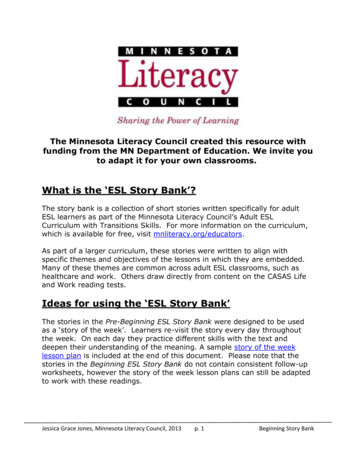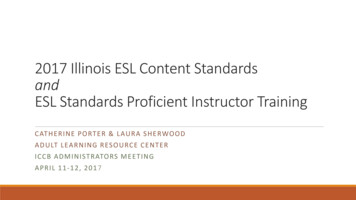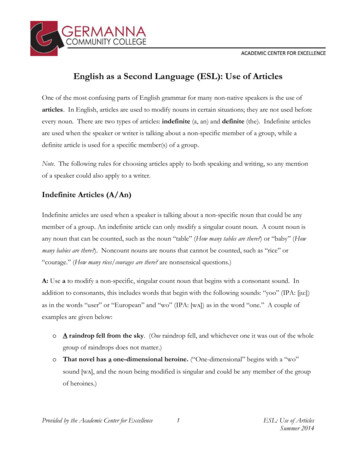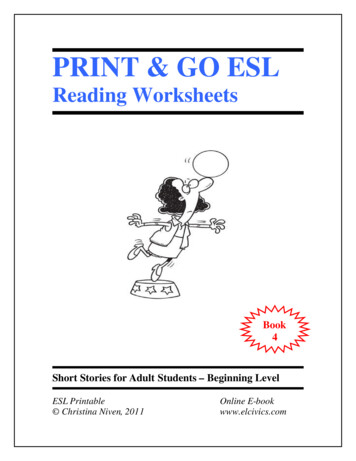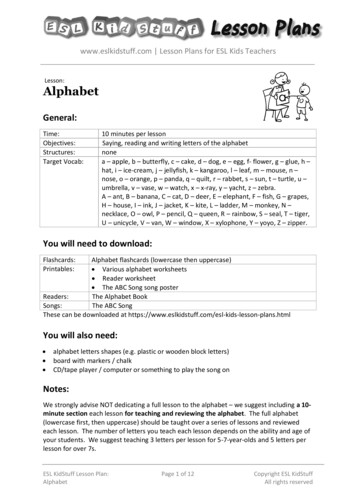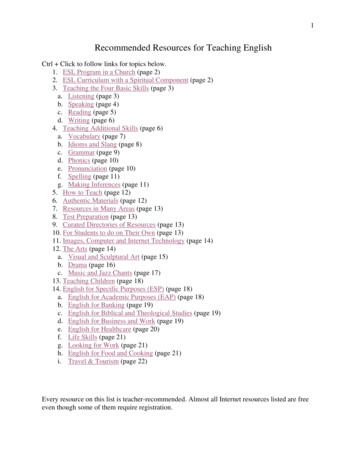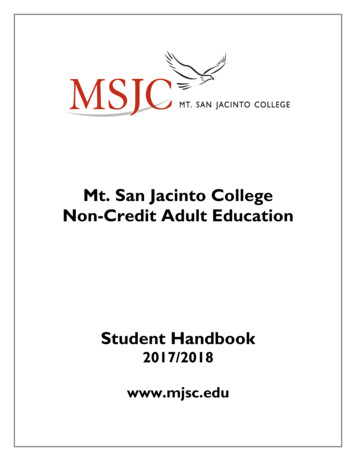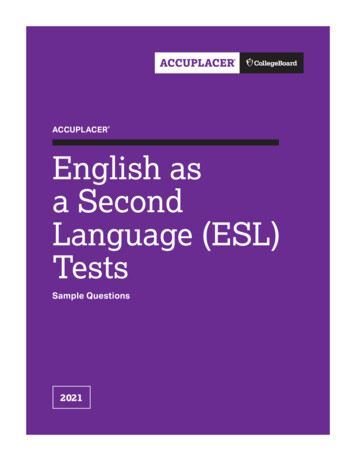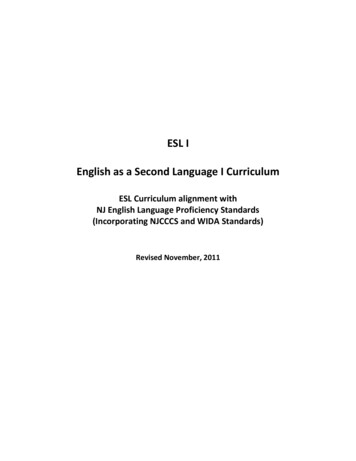
Transcription
ESL IEnglish as a Second Language I CurriculumESL Curriculum alignment withNJ English Language Proficiency Standards(Incorporating NJCCCS and WIDA Standards)Revised November, 2011
The ESL program at PCTI is designed to assist students whose first language is not English toacquire proficiency in the English language. Students receive developmentally appropriateinstruction in the areas of listening, speaking, reading and writing. Students receive one classperiod per day of English language instruction in a sheltered classroom plus in class support inhistory and science. The in class support is provided by a certified ESL teacher in conjunctionwith the classroom teacher.Students are assigned to ESL classes according to grade level. Need for ESL services isdetermined based on IPT and ACCESS test scores, other standardized test scores, prior ESLinclusion, and teacher recommendation.The ESL curriculum is aligned with the NJCCCS and WIDA standards.Ninth grade ESLRevised November, 2011I.Course descriptionNinth grade ESL is designed as an introductory course to increase students’ ability to masterEnglish language skills. Students work on increasing vocabulary skills as well as improvingreading comprehension and basic writing skills. Emphasis is made on acquiring skills necessaryto function in an English speaking environment and succeed academically.II.Course outlineA. Vocabulary (RL 9-10.4-6)1. Memorize common academic vocabulary as well as vocabulary necessary for science andhistory2. Use context clues to determine meaning3. Understand use of common synonyms and antonyms4. Understand common idiomsB. Literature (RL 9-10. 1-7, 9-10 and RI 9-10. 1-10)1. Comprehension of short passages2. Introduction to short story-comprehension/structure3. Understanding and comprehension of prose, poetry and non-fictionC. Writing (W 9-10.1-10)1. Sentence structure2. Pre-writing skillsa. brain stormingb. organization3. Paragrapha. topic sentence
b. bodyc. concluding sentence4. Revisinga. peer and teacher reviewb. personal assessment5. Researcha. use of libraryb. gathering of informationc. outlined. write, edit and reviseD. Grammar (L 9-10, 1-3)1. Mechanics2. Parts of speech3. Verb tenses4. ModifiersE. Research (RI 9-10.1-10 and W 9-10.1-10)1. Use of library to gather information2. prepare outline and notes3. write and revise paper4. document sourcesF. Communication (SL 9-10.1-6)1. Critical listening2. Ability to answer questions orally3. Ability to participate in group discussionsIII.Methods of Student EvaluationDuring each marking period in the ninth grade, a combination of the following methods will beused to evaluate each student’s performance: Class participation Writing assignments Homework and class assignments Quizzes Tests Reports/projects Research paper
Use of technologyTechnology has become increasingly important in our modern world. As a result, as part of athorough education, PCTI will be using a variety of technological programs. Some of the mostcommon programs that ESL students will use are: Blackboard Smartboard Microsoft Word Powerpoint Online Library CatalogIV.Textbooks and MaterialsSpotlight on Literature, books 3-4 (Burton Goodman, 1988)Vocabulit, book H (Perfection Learning, 2002)Grammar for Writing-blue level (Sadlier-Oxford, 2007)Miracle Worker by William Gibson(1956)The Pearl by John Steinbeck (1947)Write in Style- A Guide for the Short Term Paper by Edward P. Von der PortenReason to Write( Oxford University Press, 2003)Read and Reflect Book 1 (Oxford University Press, 2004)Supplemental workbooks in grammar, reading and writing
V.Scope and Sequence ChartGrade 9Parts of speech-identify and use correctlyI IntroducedD Developed in DepthR ReinforcedI, DVerb tenses-conjugate and use correctlyI,DWrite complete sentencesI,DLearn common idiomsI,DUse correct capitalization, basic punctuationI,DParagraph –topic sentence, body, concluding sentenceI,DExpand knowledge of vocabularyI,DDictionary-choose correct meaning in contextI,DReading-improve speed/comprehensionI,DRecognize elements of a short storyI,DBe able to summarize selectionsI,DRespond to questions orallyDParticipate in group discussionsDFollow directions given orallyDRecall information acquired from listeningDBe able to use library resources to gather informationI,DWrite a simple research paperI,DDocument research paper correctlyI,DSkill To Be Learned
Grade 9 ESL Student HandoutThe ESL program at PCTI is designed to assist students whose first language is not English toacquire proficiency in the English language. Students receive developmentally appropriateinstruction in the areas of listening, speaking, reading and writing. Students receive one classperiod per day of English language instruction in a sheltered classroom plus in class support inhistory and science. The in class support is provided by a certified ESL teacher in conjunctionwith the classroom teacher.Students are assigned to ESL classes according to grade level. Need for ESL services isdetermined based on IPT and ACCESS test scores, other standardized test scores, prior ESLinclusion, and teacher recommendation.The ESL curriculum is aligned with the NJCCCS and WIDA standards.Ninth grade ESLCourse descriptionNinth grade ESL is designed as an introductory course to increase students’ ability to masterEnglish language skills. Students work on increasing vocabulary skills as well as improvingreading comprehension and basic writing skills. Emphasis is made on acquiring skills necessaryto function in an English speaking environment and succeed academically.ProficienciesStudent will:1. Learn eight parts of speech and use correctly in speech and writing2. Learn major verb tenses and be able to use correctly in speech and writing3. Write in complete sentences4. Learn common American idioms5. Use correct punctuation and capitalization6. Be able to write a paragraph containing a topic sentence, body, and concluding sentence7. Increase knowledge of academic vocabulary8. Be able to use a dictionary to choose the correct meaning of a word in context9. Improve reading speed, comprehension10. Be able to recognize the elements of a short story/novel11. Understand the difference between prose, poetry and non-fiction12. Be able to summarize selections13. Respond to questions orally14. Participate in group discussions15. Follow directions given orally16. Recall information acquired from listening17. Be able to use library resources to gather information18. Write a basic research paper19. Use documentation to cite sources
WIDA CAN DO Descriptors: Grade Level Cluster 9-12ListeningEntering 1 Point to orshow basicparts,components,features,characteristics,and propertiesof objects,organisms, orpersonsnamed orally Matcheveryday oralinformation topictures,diagrams, orphotographs Groupvisuals bycommontraits namedorally (e.g.,“These arepolygons.”) Identifyresources,places,products,figures fromoralstatements,and visualsBeginning 2 Match orclassify oraldescriptionsto real-lifeexperiencesor visuallyrepresented,contentrelatedexamples Sort orallanguagestatementsaccording totime frames Sequencevisualsaccordingto oraldirectionsDeveloping 3 Evaluateinformationin social andacademicconversations Distinguishmain ideasfromsupportingpoints in oral,contentrelateddiscourse Uselearningstrategiesdescribedorally ding 4 Distinguishbetweenmultiplemeanings oforalwords orphrases insocialand academiccontexts Analyzecontentrelatedtasks orassignmentsbasedon oraldiscourse Categorizeexamples ofgenres readaloud Comparetraits basedonvisuals andoraldescriptionsusing specificand sometechnicallanguageBridging 5 Interpretcause andeffectscenariosfrom oraldiscourse Makeinferencesfrom oraldiscoursecontainingsatire,sarcasm, orhumor Identify andreact tosubtledifferences inspeech andregister (e.g.,hyperbole,satire,comedy) Evaluateintent ofspeechand actaccordingly
WIDA CAN DO Descriptors: Grade Level Cluster 9-12SpeakingEntering 1 Answer yes/noor choicequestions withincontextof lessons orpersonalexperiences Provideidentifyinginformationabout selfBeginning 2 Describepersons,places,events, orobjects Ask WHquestions toclarifymeaning Givefeatures of Namecontentbasedeveryday objects material (e.g.,andtimepre-taughtperiods)vocabulary Characterize Repeat words, issues,short phrases,situations,memorizedregions shownchunks ofinlanguageillustrationsDeveloping 3 Suggest ways toresolve issues orpose solutions Compare/contrastfeatures, traits,characteristics usinggeneral and somespecific language Sequenceprocesses, cycles,procedures, orevents Conductinterviews orgather informationthrough oralinteraction Estimate, makepredictions or posehypotheses frommodelsExpanding 4 Take a stanceand useevidence todefend it Explaincontentrelatedissues andconcepts Compare andcontrastpoints of view Analyze andshare pros andcons of choices Use andrespond togossip,slang, andidiomaticexpressions Use speakingstrategies (e.g.,circumlocution)Bridging 5 Givemultimedia oralpresentations ongrade-levelmaterial Engage indebates oncontent-relatedissues usingtechnicallanguage Explainmetacognitivestrategies forsolving problems(e.g., “Tell mehow you knowit.”) Negotiatemeaning in pairsor groupdiscussions
WIDA CAN DO Descriptors: Grade Level Cluster 9-12ReadingEntering 1 Match visualrepresentationsto words/phrases Read everydaysigns, symbols,schedules, andschool-relatedwords/phrases Respond to WHquestions related toillustrated text Use references(e.g., picturedictionaries, bilingualglossaries,technology)Beginning 2 Match data orinformation with itssource or genre (e.g.,description of elementto its symbol onperiodic table) Classify or organizeinformation presentedin visuals or graphs Follow multi-stepinstructions supportedby visuals or data Match sentencelevel descriptions tovisual representations Compare contentrelated features invisuals and graphics Locate main ideas ina series of relatedsentencesDeveloping 3 Apply multiplemeanings ofwords/phrasesto social andacademiccontexts Identify topicsentences ormain ideas anddetails inparagraphs Answerquestions aboutexplicitinformation intexts Differentiatebetween factand opinion intext Orderparagraphs orsequenceinformationwithinparagraphsExpanding 4 Compare/contrastauthors’ points ofview, characters,information, oreventsBridging 5 Interpret gradelevel literature Synthesizegrade-levelexpository text Interpret visuallyor graphically Drawsupportedconclusions frominformationdifferent sourcesof informational Infer meaningtextfrom text Infer Match cause tosignificance ofeffectdata orinformation in Evaluategrade-levelusefulness of data materialor informationsupported Identifyvisually orevidence of biasgraphicallyand credibility ofsource
WIDA CAN DO Descriptors: Grade Level Cluster 9-12WritingEntering 1 Label contentrelated diagrams,pictures fromword/phrase banksBeginning 2 Make contentrelated lists ofwords, phrases,or expressions Provide personalinformation onforms read orally Take notesusing graphicorganizers ormodels Produce shortanswer responsesto oral questionswith visual support Supply missingwords in shortsentences Formulateyes/no, choiceand WHquestions frommodels Correspond forsocial purposes(e.g., memos,e-mails, notes)Developing 3 Complete reportsfrom templates Compose shortnarrative andexpository pieces Outline ideas anddetails using graphicorganizersExpanding 4 Summarizecontent-relatednotes fromlectures or textBridging 5 Produceresearch reportsfrom multiplesources Revise workbased onnarrative or oralfeedback Create originalpieces thatrepresent the useof a varietyof genres anddiscourses Compose Compare andnarrative andreflect onexpository textperformance against for a varietycriteria (e.g., rubrics) of purposes Justify ordefend ideasand opinions Producecontent-relatedreports Critique, peeredit and makerecommendationson others’writing fromrubrics Explain, withdetails,phenomena,processes,procedures
The ESL program at PCTI is designed to assist students whose first language is not English to . Vocabulit, book H (Perfection Learning, 2002) Grammar for Writing-blue level (Sadlier-Oxford, 2007) Miracle Worker b

